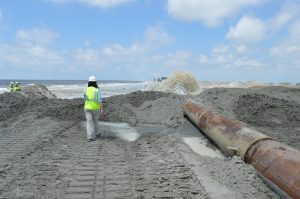After Tragedy, These Projects Bring Hope of a Brighter Future
On April 20, 2010, the Deepwater Horizon oil rig exploded, killing 11 men and leaking more than 134 million gallons of oil into the Gulf of Mexico before it was capped 87 days later. The spill oiled large swaths of wetlands and marine habitat, leaving long-lasting harm to the ecosystem.
Out of tragedy came an opportunity to invest significantly in addressing Louisiana’s land loss crisis, which the oil spill exacerbated. The state’s land loss crisis threatens the health of entire ecosystems and wildlife and the safety of communities.
In the decade since that disaster, Louisiana has used the BP settlement to address the spill’s impact and has jumpstarted the engineering and construction of restoration projects vital to rebuilding and protecting Louisiana’s degrading coastline.
Ultimately, Louisiana will receive about $7 billion through three funding streams: the National Fish and Wildlife Foundation (NFWF) Gulf Environmental Benefit Fund, the Natural Resource Damage Assessment and the RESTORE Act.
As of today, there are at least 24 restoration projects that have been completed, are in construction or are currently moving towards implementation using settlement money.
Here are highlights of some restoration projects that the state has completed or is moving forward with funds from three different funding sources from the oil spill settlement.
NFWF: Rebuilding Our First Line of Defense

The restoration of the Caminada Headlands was completed in 2017.
Many of the state’s barrier islands received extensive oiling during the 2010 spill, affecting the already shrinking beach and marsh habitats.
Some of the largest projects using oil spill money have aimed to restore several islands. The award-winning dune and beach restoration of the Caminada Headlands used 8.8 million cubic yards of sand piped in from the Gulf of Mexico. The $215.9 million project created and enhanced 1,059 acres of habitat, reinforcing six miles of barrier headland habitat.
Louisiana’s barrier islands are home to a range of shorebirds, including brown pelicans, terns, plovers, skimmers and gulls as well as marine animals like sea turtles and dolphins. They also protect the homes of hundreds of thousands of Louisianans from storm surge, serving as the first line of defense against hurricanes.
The $149 million restoration of three more barrier islands is underway, funded by NFWF, and is expected to be complete by 2022. The announcement highlighted the strong partnership developed by NFWF and the state’s Coastal Protection and Restoration Authority. It is those partnerships that will allow us to continue to make smart investments and implement innovative, large-scale solutions to address our coastal crisis.
NRDA: Creating New Marsh
One of the first projects to receive money through the Natural Resource Damage Assessment, the Lake Hermitage Marsh Creation project addressed some of the significant marsh loss facing Plaquemines Parish. That parish has lost more than 460 acres of land since 1932, leading to a decline in population.
-

People stand on a boat near the Lake Hermitage Marsh Creation project site.
- People stand on a boat near the Lake Hermitage Marsh Creation project site.
That project leveraged the NRDA money to fill 100 acres of open water with sediment to create much-needed marsh. This built off another project that was funded separately to create 600 acres of marsh.
By rebuilding and nourishing marshes, we save vital habitat and slow any further degradation by limiting the size of waves eroding the area.
Currently, the draft plan for the Large-Scale Barataria Marsh Creation: Upper Barataria Component project is available for public comment. That NRDA-funded project would restore 1,207 acres of marsh that protect the surrounding communities and wildlife.
RESTORE: Slowing Saltwater’s Destructive Intrusion
At 110-feet wide and 800-feet long, the Houma Navigation Canal Lock Complex will help tackle the persistent saltwater intrusion that has eaten away at freshwater wetlands in the Terrebonne Basin. The Terrebonne Basin is experiencing some of the most severe land loss on the planet.
As water becomes saltier with the encroachment of the Gulf, more of the wetlands are dying, allowing the Gulf to push further inland. The weakened wetlands also lose their ability to host species like black willow trees that absorb winds and limit erosion or marsh grasses that filter the sediment and water.
The RESTORE Council has contributed $18.5 million to design the complex. Local and state officials are hoping to receive more RESTORE money to cover construction and complete the structure by 2024.
While the oil disaster caused widespread devastation, Louisiana has managed to rise from the occasion to improve our coast’s resilience.
Of the $16.67 billion made available Gulf-wide, about $12.015 billion remains. In Louisiana alone, our Coastal Master Plan outlines $50 billion worth of projects over 50 years that are necessary to ensure we fortify our coast against the forces of subsidence and climate change. While we continue our push forward, the strides made over the past decade exemplify that a more sustainable delta is possible.
Learn more about progress made since the oil spill and opportunities to help ecosystems, wildlife and communities become more resilient at http://mississippiriverdelta.org/decade-after-disaster/